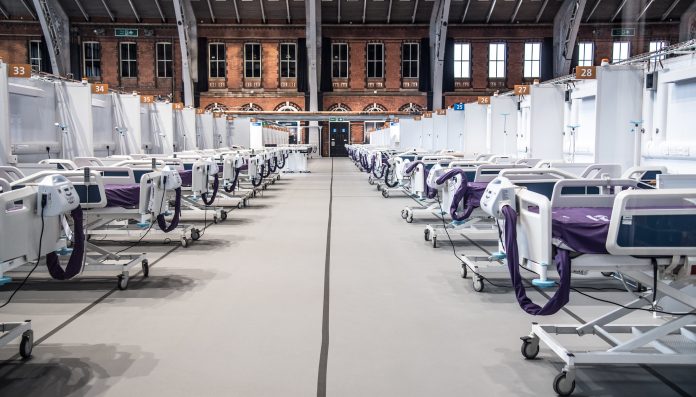Professor Peter Guthrie OBE FREng, vice-president of the Royal Academy of Engineering, discusses its call for transformational changes across the built environment and its underlying regulatory framework in response to the weaknesses uncovered by the Covid-19 pandemic
In June, the National Engineering Policy Centre (NEPC) published a new report – Infection Resilient Environments: Time for a Major Upgrade. Covid-19 is still very prevalent in the UK; in late June infections rose to an estimated 2.3m, an increase of 32%, and hospitalisations are also starting to climb again.
The ongoing pandemic has been a stark illustration of the impact of rapid transmission of infections, from deaths, long-term illnesses and a strain on the healthcare system, through to a reduction in business output and impact on education. According to an economic assessment that informed the report, the monetary cost to the UK of another severe pandemic could equate to £23bn a year.
Even without the extreme circumstances of a pandemic, estimates of seasonal diseases could cost as much as £8bn a year in disruption and sick days.
Reducing the transmission of seasonal diseases
Improvements are needed across commercial, residential, and public buildings, including schools, hospitals and transport hubs to reduce transmission of future waves of Covid-19, new pandemics, seasonal influenza and other infectious diseases.
Our built environment and public transport systems have a role to play in reducing transmission, whether that is through the provision of clean air to reduce aerosol transmission, design to minimise touch points or the plumbing configuration. Covid-19 has shone a light on poorly ventilated spaces, which have contributed to super-spreader events, and this will continue to be a challenge for any aerosol-transmitted diseases such as flu.
A lack of consideration of the long-term operation of buildings has contributed to a culture in which the spaces we live and work in actually contribute to adverse health impacts. This is because much of the UK’s built environment is not operated at the design specifications set out in Building Regulations, and much of it is unmanaged or inexpertly managed.
The NEPC report makes eight policy recommendations for improving the way our indoor environments are designed, commissioned, operated and managed. It highlights a role for the British Standards Institution, the UK Health & Security Agency, and regulators to consider health in its broadest sense. The report calls for the government to seize the opportunity from the net zero transition to encourage long-term improvements in our buildings to create safe, healthy and sustainable indoor environments.
Embedding health across building practices
We all have a right to expect that our indoor spaces are safe, this needs to encompass all aspects of health, not just structural and fire safety or clean water. However, the considerations for healthy buildings are distributed across different parts of the existing building regulations and enforced for specific risks through a range of regulators such as the Health and Safety Executive or the Food Standards Agency. Health and wellbeing need greater prominence within UK building regulations to ensure the built environment can actively help to minimise spread of infections.
This requires us to establish good practices and embed them in regulations and standards that apply throughout an asset’s lifetime. This will require new in-use regulations. Enforcement will also need better skills and capacity within the regulators. Maintaining the healthy operation of our built environment will require upskilling of building services engineers and facilities managers, supported by appropriate codes of practice.
This report recognises the role for non-regulatory measures, highlighting a major gap in the commissioning process, whereby a building’s systems are tested to ensure effective operation, but this does not always ensure that the building is functioning as designed. The process is often time-limited, under-resourced and fails to deliver on the intended outcomes. Commissioning practices need to be embedded in procurement and contracting processes to encourage quality assurance.
A people-centric approach to policymaking is needed
We have a timely opportunity to align improvements in infection resilience with our existing commitments to retrofitting buildings as part of the Net Zero Strategy, when we can take a coordinated approach to achieve infection resilience alongside improvements in energy efficiency and fire safety.
However, the energy demands of some systems, such as ventilation, can create tensions that need to be balanced. To be effective, upgrades need to be driven by a people-centric approach that considers input from relevant stakeholders and understands specific end-user needs.
It will be important to upskill the engineers who will be delivering such retrofitting to be able to make informed decisions about the best systems to deploy based on level of risk. Changes must be informed by continued multidisciplinary research. Strategic coordination from government will be required to ensure joined-up policymaking with consideration of the health, environmental, economic and social implications of any policy change.
Government chief scientific adviser Sir Patrick Vallance FRS FMedSci, who commissioned the report, emphasised that: “We spend most of our time in indoor environments and making these healthier and more sustainable spaces will have wide benefits to our public health, wellbeing and the economy. This will require action.”
The full report, reviewing opportunities for the industry to make impactful changes, is available at www.raeng.org.uk/infection-resilient-environments.
Professor Peter Guthrie OBE FREng 
Vice-president
Royal Academy of Engineering
Tel: +44(0) 020 7766 0600

















